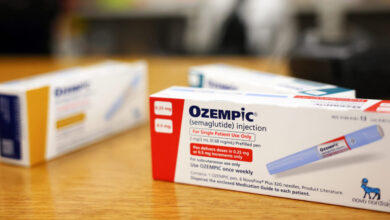Takeda, Disc Medicine, Covid-19 vaccines

Want to stay on top of the science and politics driving biotech today? Sign up to get our biotech newsletter in your inbox.
Hello! Today, we talk about the uptick in physicians using ctDNA to determine if resected cancers are truly gone, we see the FDA offering new guidelines for Covid-19 vaccines, and more.
The need-to-know this morning
- Takeda reported negative results from two Phase 3 studies investigating the use of an experimental drug called soticlestat for the treatment of Dravet syndrome and Lennox-Gastaut syndrome — rare forms of epilepsy. Shares of Ovid Therapeutics, which had licensed soticlestat to Takeda, fell sharply in early trading.
More physicians are using ctDNA tests
Clinicians are increasingly using blood tests that measure circulating tumor DNA, or ctDNA, to figure out whether any cancerous cells remain after a malignancy is removed. One of the most popular ctDNA diagnostics is the Signatera test made by Natera; revenue for the company was up 52% in the last year.
“We are all recognizing that if a patient has detectable circulating tumor DNA, it’s not a question of if the cancer’s coming back, but when,” one oncologist told STAT’s Angus Chen. “The field recognizes the power of this tool, but I think there remain many questions of how best do we utilize that in the day-to-day management of patients.”
FDA offers new guidelines for Covid-19 vaccine
From STAT’s Helen Branswell: The Food and Drug Administration has changed its advice to Covid-19 vaccine manufacturers, asking them to target the KP.2 subvariant of the virus in their fall boosters, if they are able. Earlier this month an FDA expert panel recommended the fall shots should target the JN.1 subvariant, from which KP.2 derives. After that meeting of the Vaccines and Related Biological Products Advisory Committee, the agency told manufacturers to target the JN.1 virus. But late last week, the FDA changed its advice, hoping to more closely align the fall shots to the circulating viruses.
Both Pfizer and Moderna indicated that they could make vaccine targeting either version of the virus, and still deliver their doses in August. But Novavax’s production process takes longer; at the early June meeting of the expert panel, the company said it could only make JN.1 vaccine for this fall. Novavax started making doses targeting JN.1 after the WHO recommended that version of the virus for fall shots in late April. On Friday, the company announced it had filed an application for its updated shot with the FDA.
The chair of the WHO’s coronavirus vaccine panel told the VRBPAC meeting that it’s hard to gauge at this point whether JN.1 or KP.2 would offer better protection next winter, given the continued evolution of the virus. “KP.2 may be better. But it could also be worse,” said David Wentworth, who also heads the coronavirus division at the Centers for Disease Control and Prevention.
USPTO seeks to prevent patent thickets
The U.S. Patent and Trademark Office has proposed a new way to prevent pharma companies from using patent thickets to postpone generic drugs from making it to market. The potential new rule has to do with “terminal disclaimers,” which allow branded drugmakers to skirt rules and, in essence, get more than one patent for an invention.
Under the proposed rule, if a key patent is later invalidated either through patent infringement litigation in court or a PTO board ruling, the brand-name drug company would agree not to enforce any of the other patents that were linked by the terminal disclaimer.
“In one fell swoop, it can make a difference, and would address patent thickets,” one pharma patent expert told STAT. “Instead of having to challenge, say, 100 different patents, I just have to figure out how they are linked together and try to invalidate the weakest claim.”
Why Disc Medicine’s shares jumped last week
Shares in Disc Medicine jumped about 18% Friday after two bits of news: It announced a stock offering priced at $36 per share, with aims to raise $178 million. And it announced positive data for three clinical-stage programs during the European Hematology Association meeting last week.
The Boston-area company is developing a drug called bitopertin for erythropoietic protoporphyria, a rare disease that causes photosensitivity and liver problems. Phase 2 results showed significant reductions in a substance called protoporphyrin IX, which increases in patients with the rare blood disease. A Phase 1b/2a study also showed promise in myelofibrosis, and a Phase 1 trial also demonstrated safety and efficacy among healthy volunteers.



